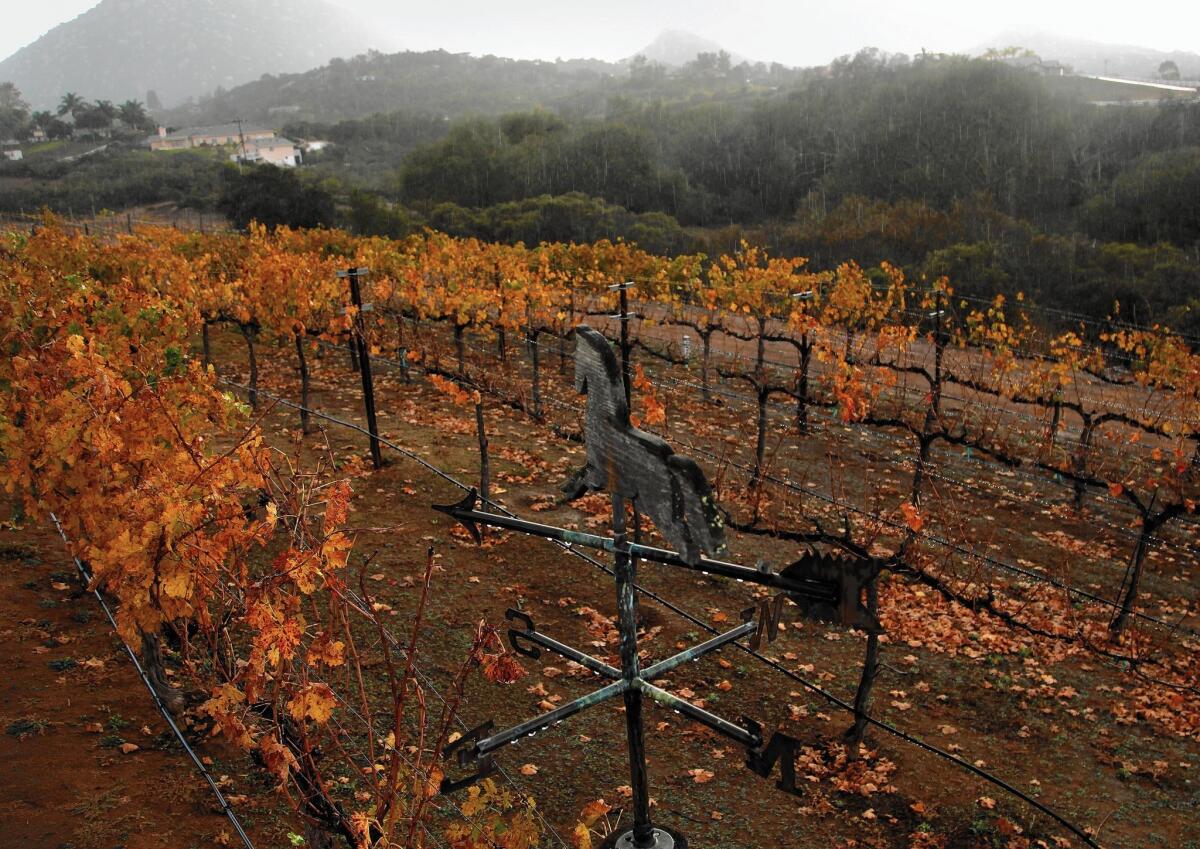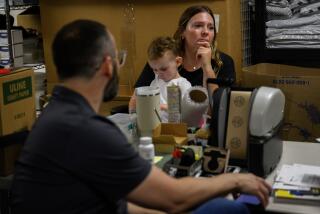Proposed San Diego County law could change the meaning of ‘local’ wine

By the time this issue is settled, everyone is going to want a drink.
But the question is whether that beverage will be a glass of red made by a boutique winery with grapes grown in San Diego County, or if that wine will come from a local business that trucks in bulk wine from around the world, puts it into bottles and sells it with its own name on the label.
County government is considering amendments to its 2010 winery ordinance, a law that made it possible for small businesses in unincorporated parts of San Diego County to turn grapes into wine, offer tastings and sell the product by the bottle. The changes could more strictly define what is and what isn’t a San Diego wine and reshape the county’s fledgling, and quickly expanding, wine industry.
By one measure, the 2010 ordinance was successful; it eliminated the need for most wineries to get a major use permit, cutting one startup cost alone by an estimated $250,000. With this financial hurdle gone, the county saw quick growth in its wine industry, particularly in the Ramona area where the number of boutique wineries — small businesses that make fewer than 12,000 gallons of wine per year — exploded from two to approximately 30 in five years.
Despite this expansion, some of the ordinance’s biggest proponents are concerned how the winemaking industry interpreted the groundbreaking law.
“We gave birth to this child, this winery ordinance, and we have some growing pains that need to be dealt with,” Supervisor Dianne Jacob said.
Hence, the amendments.
Supporters argue the ordinance not only made it easier for vintners and winemakers in the county, but that it also brought a bunch of “rogue” wineries that cut corners. They weren’t using locally grown grapes, were sometimes just rebottling imported wine and weren’t honoring the spirit of the ordinance. What’s behind the cork wasn’t an authentic San Diego wine, they said.
“It’s not about bringing the bulk wine in, or ‘playing house’ as I call it,” said Carolyn Harris, the vice president and general counsel for the Ramona Valley Winery Assn.
Many wineries also opened restaurants, book live entertainment and host events on their property. It was becoming less about locally grown grapes and niche wines as much as it became about the winery experience, supporters of the revisions say.
“What happened was — it was wild and unexpected, honestly — it was a lot of wineries that just decided to take the shortcuts and go for it,” Harris said.
She believes that nearly a quarter of the wineries in Ramona Valley aren’t complying with the 2010 ordinance.
Bringing in grapes and premade bulk wine aren’t shortcuts but rather legitimate business necessities that are common throughout the industry, opponents of the proposed amendment said. And entertainment and food add to the wine tasting, and are an important part of making sure customers have a good time, tell their friends and come back.
“When they come in, it’s all about the experience,” said Peter Clarke, owner of Altipiano Vineyard just outside Escondido.
More than 3,000 types of grapes are used in winemaking, but the vast majority, particularly ones used in white wines, don’t grow well in this region or are too expensive to grow locally, amendment opponents said. If they didn’t bring in fruit or bulk wines from outside San Diego County, they couldn’t make or sell the beverages their customers want to buy. Vineyards and winemaking are expensive and time-consuming endeavors, and the proposed amendments don’t leave room for the complex nuances of the business, they said.
“Nobody is getting rich here in San Diego County in this industry,” said Eric Metz, one of the owners of Lenora Winery in Ramona. “This is a very capital-intensive industry. The equipment is very expensive, you have land that you paid for, the water is very expensive and your time is very expensive. We don’t have a good labor pool so the owners of these wineries are often doing all the work.”
Any change to the 2010 ordinance would be a setback, he said.
The proposed amendments govern advertising, food at tasting rooms, hours wineries can serve the public, record keeping and other provisions. None is as controversial as a regulation that allows, at most, a quarter of the grapes used in wine production to come from outside of the county. The rest must all be grown from within the county, and 25 percent must be grown on the winery’s premises. Another controversial amendment prohibits county wineries from using or selling premade bulk wine.
“Should the ordinance go forward as written, many fear that the end result will be the death of the San Diego boutique wineries, not their potential growth,” Teri Kerns, co-owner of Ramona Ranch Winery, said at a hearing this summer.
The county’s hilly rural areas and rough terrain make it prohibitively expensive to make wine entirely from local grapes, and even so, there aren’t enough vineyards to satisfy winemakers’ demands, according to critics of the proposed changes. The combination of scarcity and cost makes wineries look elsewhere for cheaper, more plentiful, fruits, Clarke said.
Vintners also have a limited selection of grapes they can grow, he said. Some varieties, including grapes used in some of the most popular types of wines, are poorly suited for the region’s’ climate and terrain. The only way to sell these types of wine in San Diego is to get them from elsewhere, Clarke said.
“I know of very few places that don’t bring in white wine under the current ordinance,” he said. His winery offers a Santa Barbara Pinot Grigio in its six-wine tasting because that type of wine can’t be made on-site.
Even still, good winemaking sometimes requires using grapes or bulk wines from other vineyards or wineries, Metz said. Winemakers can use premade wine to enhance the flavor of wine they made themselves, or turn it into dessert wine, or use their own know-how to fix a mistake another winemaker made.
“You can actually make better wine, you can reduce your costs a little bit, and it’s legal throughout the state. There’s absolutely nothing wrong with doing that,” he said.
Prohibiting this practice would mean that wineries based in unincorporated parts of the county would have to compete for customers against “urban wineries” in nearby cities that don’t have this restriction, Clarke said.
Harris and the businesses she represents are concerned that shortcuts are watering down the region’s wineries and making the industry less about supporting agriculture and more about supporting wine sales. The ordinance was supposed to support vintners who turn their own grapes into a limited number of high-quality wines rather than businesses that open a rural tasting room akin to a sports bar, she said.
“It’s not going to become a circus,” she said.
The amendments would hone rules in the 2010 ordinance in order to put a greater emphasis on wines made from fruit grown within the county, Harris said.
Some existing boutique wineries would be out of bounds under the amended rules, but they wouldn’t necessarily need to close down. Permits cover their businesses, including one for small wineries that allow for as much as half of the grapes or juice to come from outside of San Diego County.
“They can go get an administrative use permit,” Harris said. “They can do what they would like, but they’re whining and crying and screaming ... if they would go and apply for an administrative use permit, it’s likely their project would qualify for it.”
The county accepted public comment on the proposed amendment through Monday, and planners are reviewing suggestions and fine-tuning the proposed amendments. The revised ordinance is expected to go to the Planning Commission in early 2016 and to the Board of Supervisors in late March or early April.
Stewart writes for the San Diego Union-Tribune.
ALSO
Private-sector job growth accelerated to 217,000 in November, ADP says
Two NFL owners hoping Los Angeles relocation vote takes place in January
PAC shielded $2.3 million in donations by L.A. charter school backers
More to Read
Sign up for Essential California
The most important California stories and recommendations in your inbox every morning.
You may occasionally receive promotional content from the Los Angeles Times.










